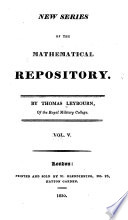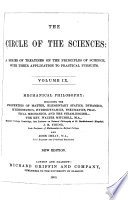 | Thomas Leybourn - 1830 - 630 pages
...by a separate spring ; first, when the strings are parallel ; secondly, when they are not. 2. Find the resultant of any number of parallel forces acting on a rigid body, and shew that they cannot in all Cases be reduced to a single force which shall have the same effect.... | |
 | William Whewell - 1832 - 572 pages
...above given is valid. CHAP. III. THE CONDITIONS OF EQUILIBRIUM OI'' A RIGID BODY. 23. PROP, To find the resultant of any number of parallel forces acting on a rigid body. Fig. 105. Let any number of parallel forces p,, p2, p3, &c. act upon a rigid body. Let a plane yAx... | |
 | Isaac Todhunter - 1853 - 362 pages
...CHAPTEE IV. RESULTANT OF FORCES IN ONE PLANE. CONDITIONS OF EQUILIBRIUM. MOMENTS. 52. PROP. To find the resultant of any number of parallel forces acting on a rigid body in one plane. Let P,, P 2 , P 3 ...... denote the forces. Take any point in the plane of the forces... | |
 | William Somerville Orr - 1860 - 540 pages
...for any number of forces acting on a rigid body. PROPOSITION XVII. Toßnd the magnitude and direction of the resultant of any number of parallel forces acting on a rigid body in the same plane. Let four parallel forces, Plt P2, P3, and P4, acting in the same plane on the points... | |
 | Morin (M., Arthur Jules) - 1860 - 476 pages
...forces is established in a similar manner for parallel forces. 131. Centre of parallel forces.— The point of application of the resultant of any number of parallel forces, acting upon a body, depends only upon the ratio between their intensities and not upon their direction. Consequently,... | |
 | Isaac Todhunter - 1866 - 386 pages
...couple whose moment is CHAPTER V. FORCES IN DIFFERENT PLANES. 66. To find the magnitude and direction of the resultant of any number of parallel forces acting on a rigid body, and to determine the centre of parallel forces. Let the points of application of the forces be referred... | |
 | J W. Mulcaster - 1871 - 242 pages
...the same laws as that of a force. CONDITIONS OF EQUILIBRIUM. PARALLEL FORCES. 73. PROP. I. To find the resultant of any number of parallel forces acting on a rigid body in one plane. Let P l, P 2) P v &c. be any number of parallel forces acting on a rigid body in one... | |
 | W. G. Willson - 1874 - 294 pages
...parallel forces can be determined analytically. 79. To determine analytically the position and magnitude of the resultant of any number of parallel forces acting on a rigid body. Let the forces be Pl; P2, P3 , and let A, B, C, be points on their lines of action. Take any plane... | |
 | George Anthony Hill - 1880 - 204 pages
...This is true whatever be the number of the forces, and this remarkable constancy in position of the point of application of the resultant of any number . of parallel forces has caused it to be called the centre of the system of parallel forces. 198. A couple is a system of... | |
 | Joshua Joseph J. Doherty - 1881 - 240 pages
...which it acts ; and it cannot be balanced by any single force. 189. Tpjmd the magnitude, direction, and point of application of the resultant of any number of parallel forces 1vhich are cither in the same, or in different planes. Let the forces be P, Q, S, T, acting at the... | |
| |